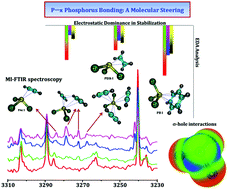Dominance of unique P⋯π phosphorus bonding with π donors: evidence using matrix isolation infrared spectroscopy and computational methodology†
Abstract
Albeit the first account of hypervalent⋯π interactions has been reported with halogen⋯π interactions, the feasibility of their extension to other hypervalent atoms as possible Lewis acids is still open. In this work, the role of phosphorus as an acceptor from the π electron cloud (P⋯π pnicogen or phosphorus bonding) in PCl3–C2H2 and PCl3–C2H4 heterodimers is explored, by combining matrix isolation infrared spectroscopy with ab initio and DFT computational methodologies. The respective potential energy surfaces of the PCl3–C2H2 and PCl3–C2H4 heterodimers reveal unique minima stabilized by a concert of reasonably strong to weak interactions, of which P⋯π phosphorus bonding was energetically dominant. Heterodimers, trimers and tetramers bound primarily by this unique phosphorus bond were generated at low temperatures. The dominance of phosphorus bonding in the PCl3–C2H2 and PCl3–C2H4 heterodimers over other interactions (such as H⋯π, H⋯Cl, H⋯P, Cl⋯π and lone pair–π interactions) was confirmed and substantiated using extended quantum theory of atoms in molecules, natural bond orbital, electrostatic potential mapping and energy decomposition analyses. The following inferences in correlation with results from non-covalent-interaction analysis offer a complete understanding of the nature of the P⋯π phosphorus bonding interactions. The significance of electrostatic forces kinetically favoring the formation of phosphorus bonded heterodimers, in addition to thermodynamic stabilization, is demonstrated experimentally.



 Please wait while we load your content...
Please wait while we load your content...